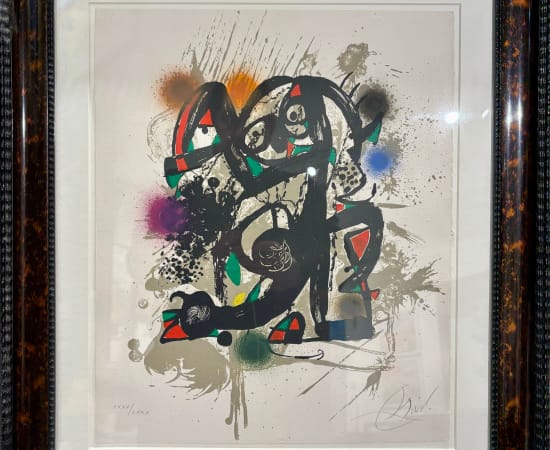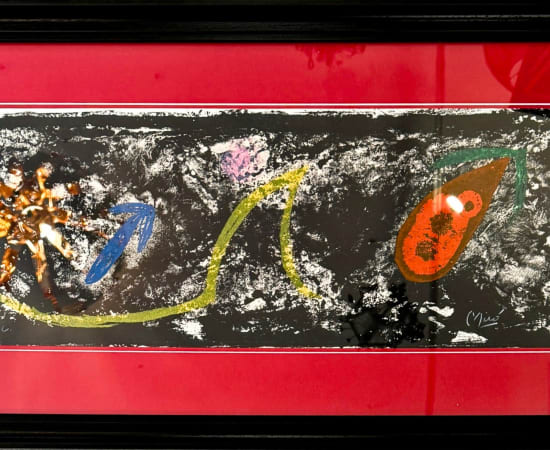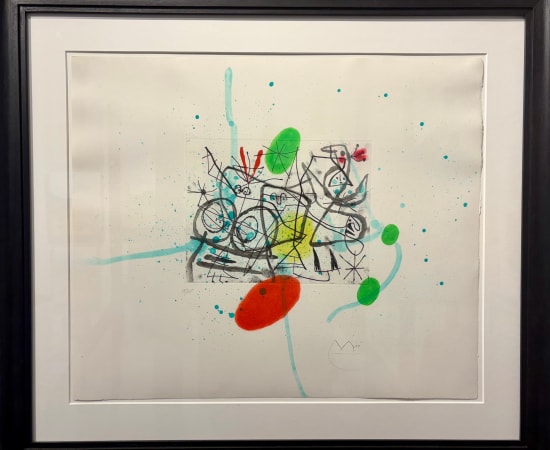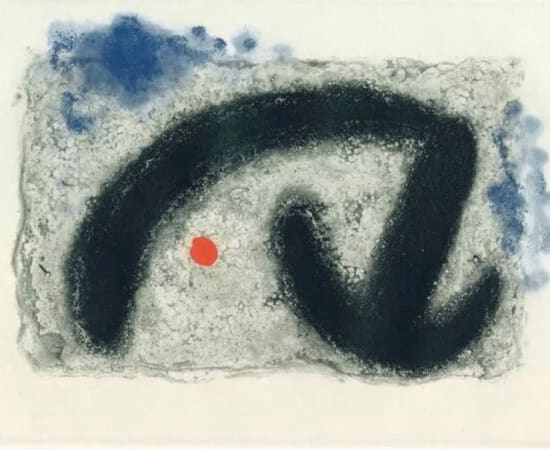Joan Miro Spanish, 1893-1983
-
 Joan MiroLithographs III / Maeght 1118 , 1977LithographEdition of 80
Joan MiroLithographs III / Maeght 1118 , 1977LithographEdition of 80 -
 Joan MiroLes Penalites De L'enfer Ou Les Nouvelles-Hebrides (s.9758) The Penalties of Hell or the New Hebrides, 1974: Original Lithograph on Arches paper20 x 39 in
Joan MiroLes Penalites De L'enfer Ou Les Nouvelles-Hebrides (s.9758) The Penalties of Hell or the New Hebrides, 1974: Original Lithograph on Arches paper20 x 39 in
50.8 x 99.1 cm -
 Joan MiroPreparatifs d'oiseaux III (Preparations for Birds), 1963Etching & Aquatint30 3/4 x 27 1/8 in
Joan MiroPreparatifs d'oiseaux III (Preparations for Birds), 1963Etching & Aquatint30 3/4 x 27 1/8 in
78 x 69 cmEdition of 75 -
 Joan MiroNous Avons , 1959Original etching and aquatint19 3/4 x 23 5/8 in
Joan MiroNous Avons , 1959Original etching and aquatint19 3/4 x 23 5/8 in
50 x 60 cmEdition of 50
Joan Miró was born on April 20, 1893, in Barcelona, Spain. The son of a watchmaker and a goldsmith, Miró showed an early interest in art, beginning his formal art education at the age of 14 at the La Lonja School of Fine Arts in Barcelona. He later continued his studies at the Cercle Artístic de Sant Lluc and the Gali Academy, where he was influenced by the Catalan modernism movement.
Early Career and Influences
Miró’s early works were influenced by various art movements, including Fauvism, Cubism, and Surrealism. His first solo exhibition in 1918 at the Dalmau Gallery in Barcelona was not well-received, but it marked the beginning of his unique style. In 1920, Miró moved to Paris, where he met influential artists such as Pablo Picasso and André Breton, the founder of Surrealism.
Development of Style
In Paris, Miró began to develop his distinctive style characterized by bright colors, organic forms, and playful compositions. His work from this period often featured fantastical imagery and was deeply influenced by dreams and subconscious thoughts. One of his most famous early works, “The Farm” (1921-1922), exemplifies his meticulous attention to detail and symbolic use of objects.
Surrealism and Recognition
By the mid-1920s, Miró had become associated with the Surrealist movement. His paintings, such as “Harlequin’s Carnival” (1924-1925) and “Dog Barking at the Moon” (1926), showcased his imaginative use of biomorphic shapes and abstracted forms. His work gained international recognition, leading to exhibitions in Europe and the United States.
World War II and Later Works
During the Spanish Civil War and World War II, Miró returned to Spain and continued to work on his art, producing the notable “Constellations” series. This series of 23 gouaches, created between 1940 and 1941, is celebrated for its lyrical abstraction and intricate compositions.
Post-war, Miró’s work evolved further, incorporating new materials and techniques. He explored sculpture, ceramics, and public art, creating significant works such as the ceramic mural for the UNESCO building in Paris (1955-1958) and the “Woman and Bird” sculpture in Barcelona (1982).
Legacy and Influence
Joan Miró’s contributions to modern art are immense, with his work continuing to inspire and influence contemporary artists. He is celebrated for his innovative approach to form and color, his playful and poetic imagination, and his ability to convey profound ideas through seemingly simple imagery. Miró’s works are housed in major museums worldwide, including the Fundació Joan Miró in Barcelona and the Museum of Modern Art in New York.
Why Investing in Joan Miró’s Work is a Good Investment
1. Art Historical Significance:
Miró is a seminal figure in 20th-century art, with his works marking important developments in Surrealism and abstract art. Owning a piece of Miró’s art is owning a piece of art history.
2. Market Performance:
Miró’s works consistently achieve high prices at auction. His unique style and enduring popularity among collectors ensure strong demand and investment potential.
3. Limited Supply:
As with many great artists, the finite number of works produced by Miró adds to their rarity and value. His works are highly sought after, contributing to their appreciation over time.
4. Diverse Portfolio:
Miró’s body of work spans various mediums, including painting, sculpture, ceramics, and prints. This diversity allows collectors to invest in different types of his work, each with its own appeal and market.
5. Global Recognition:
Miró’s works are held in prestigious museums and collections worldwide, ensuring ongoing visibility and appreciation. This global recognition supports the long-term value of his art.
References:
Investing in Joan Miró’s work is not only a way to own a piece of vibrant and imaginative art but also a sound financial decision given his established reputation, market performance, and significant contribution to modern art.







